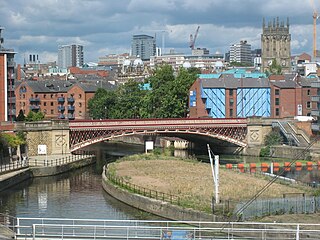
West Yorkshire is a metropolitan and ceremonial county in the Yorkshire and the Humber region of England. It is an inland and upland county having eastward-draining valleys while taking in the moors of the Pennines. West Yorkshire came into existence as a metropolitan county in 1974 after the reorganisation of the Local Government Act 1972 which saw it formed from a large part of the West Riding of Yorkshire. The county had a population of 2.3 million in the 2011 census making it the fourth-largest by population in England. The largest towns are Huddersfield, Castleford, Batley, Bingley, Pontefract, Halifax, Brighouse, Keighley, Pudsey, Morley and Dewsbury. The three cities of West Yorkshire are Bradford, Leeds and Wakefield.

Batley is a market town in the Metropolitan Borough of Kirklees, in West Yorkshire, England. Batley lies south-west of Leeds, north-west of Wakefield and Dewsbury, south-east of Bradford and north-east of Huddersfield. Batley is part of the Heavy Woollen District. In 2011 the population of Batley including Hanging Heaton, Staincliffe, Carlinghow, Birstall, Birstall Smithies, Copley Hill and Howden Clough was 48,730.

Dewsbury is a minster and market town in the Metropolitan Borough of Kirklees in West Yorkshire, England. It lies on the River Calder and on an arm of the Calder and Hebble Navigation waterway. It is to the west of Wakefield, east of Huddersfield and south of Leeds.

Kirklees is a local government district of West Yorkshire, England, governed by Kirklees Council with the status of a metropolitan borough. The largest town and administrative centre of Kirklees is Huddersfield, and the district also includes Batley, Birstall, Cleckheaton, Denby Dale, Dewsbury, Heckmondwike, Holmfirth, Kirkburton, Marsden, Meltham, Mirfield and Slaithwaite. Kirklees had a population of 422,500 in 2011; it is also the third largest metropolitan district in England by area size, behind Doncaster and Leeds.

Huddersfield is a market town in the Kirklees district in West Yorkshire, England. It is the administrative centre and largest settlement in the Kirklees district. The town is in the foothills of the Pennines. The River Holme's confluence into the similar-sized Colne to the south of the town centre which then flows into the Calder in the north eastern outskirts of the town.
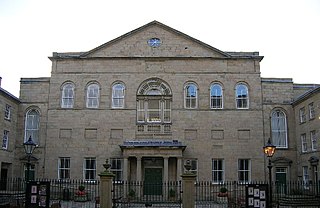
The Lawrence Batley Theatre is a theatre in Huddersfield, West Yorkshire, England which offers drama, music, dance and comedy.

Batley and Spen is a constituency in the House of Commons of the UK Parliament.
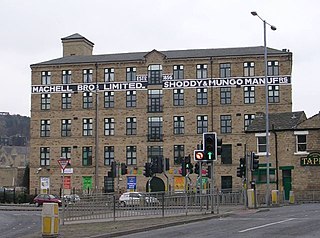
The Heavy Woollen District is a region of textile-focused industrial development in West Yorkshire, England. It acquired the name because of the heavyweight cloth manufactured there from the early 19th century.
The Arts Council Collection is a national loan collection of modern and contemporary British art. It was founded in 1946. The collection continues to acquire works each year. The Arts Council Collection reaches its audience through loans to public institutions, touring exhibitions, digital and outreach projects. The collection supports artists based in the UK through the purchase and display of their work, safeguarding it.

Cartwright Hall is the civic art gallery in Bradford, West Yorkshire, England, situated about a mile from the city centre in the Manningham district. It was built on the former site of Manningham Hall using a gift of £40,000 donated by Samuel Lister and it is named after Edmund Cartwright. The gallery which opened in 1904 initially had a display of artworks loaned from other galleries and private collections until it was able to purchase a permanent collection of Victorian and Edwardian works using money raised by the 1904 Bradford Exhibition.

Batley railway station serves the large town of Batley in West Yorkshire, England. Situated 8 miles (13 km) south-west of Leeds on the main line to Huddersfield and Manchester, the station was opened by the London and North Western Railway in 1848.

The Tolson Memorial Museum, also known as Tolson Museum, is housed in Ravensknowle Hall, a Victorian mansion in Ravensknowle Park on Wakefield Road in Huddersfield, West Yorkshire, England. The museum was given to the town by Legh Tolson in memory of his two nephews who were killed in the First World War. Originally a natural history museum, it is run by Kirklees Council and has a wide range of exhibits related to the area's cultural and industrial history.

Robert Priseman is a British artist, collector, writer, curator and publisher who lives and works in Essex, England. Over 200 works of art by Priseman are held in art museum collections around the world including the V&A, Museum der Moderne Salzburg, Art Gallery of New South Wales, Musée de Louvain la Neuve, The Royal Collection at Windsor Castle, The Allen Memorial Art Museum, The Mead Art Museum, Honolulu Museum of Art and The National Galleries of Scotland.

Kathryn Mary Pinnock, Baroness Pinnock is a British Liberal Democrat politician, life peer, and former school teacher. Since 1987, she has been a member of Kirklees Metropolitan Borough Council. She was leader of the council's Lib Dem group from 1991 to 2014, and leader of the council from 2000 to 2006. She was created a life peer in 2014 and now sits in the House of Lords.
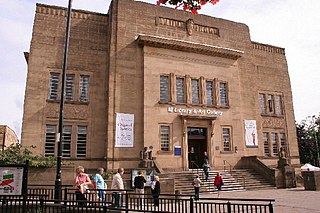
The Huddersfield Art Gallery is an art gallery in Huddersfield, West Yorkshire, northern England. It is currently owned and operated by Kirklees Council.

Wilton Park is a public park located in Batley, West Yorkshire, England.
Dr Ammanichanda Nima Poovaya-Smith OBE is a museum curator, art historian and writer. She is known for her work on transcultural and post-colonial South Asian museum collections in Bradford.
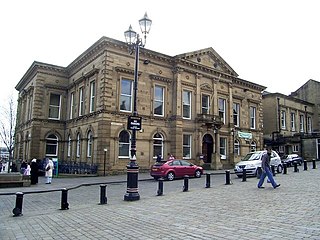
Batley Town Hall is a municipal facility in the Market Place in Batley, West Yorkshire, England. It is a Grade II listed building.

Hilda Annetta Walker FRSA was an English sculptor, and a painter of landscapes, seascapes and horses, flourishing between 1902 and 1958. She was a war artist painting in England during the First and Second World Wars, and described as "escapist". Some of her early work was the production of oilette postcard paintings for Raphael Tuck & Sons, of firemen and horses. She was born in Mirfield, Yorkshire, England, to a family of blanket manufacturers who had the means to foster her art education. She grew up in the Protestant work ethic of Congregationalism, and attended Leeds College of Art, where she studied under William Gilbert Foster of the Staithes group and William Charles Holland King, sculptor of Dover Marine War Memorial. She signed her works "Hilda Walker" or sometimes "Hilda A. Walker".


















